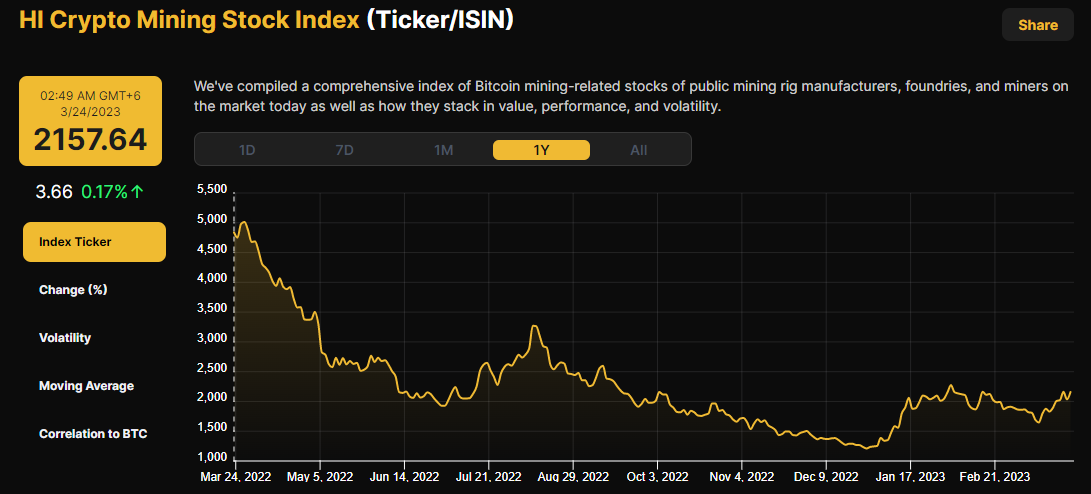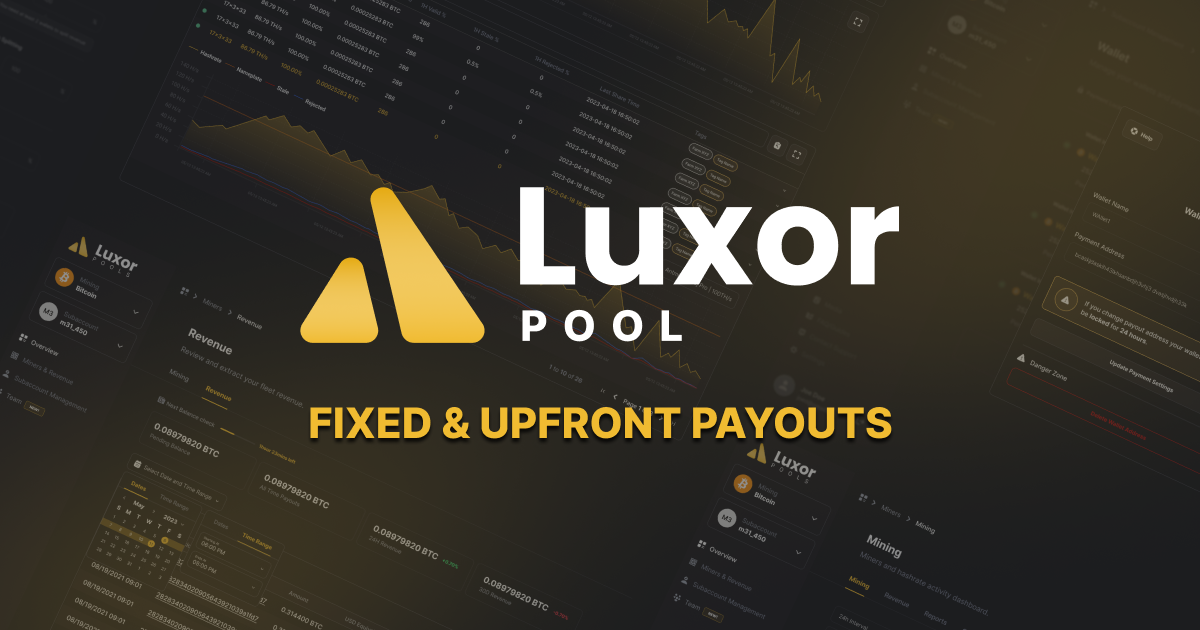
7 Ways to Get Financial Exposure to Bitcoin Mining
Investors seeking financial exposure to bitcoin mining can choose between several options, each with its advantages and disadvantages.
It’s critical to be aware of the fundamentals of these investment structures, as they possess wildly different characteristics in complexity, liquidity, transaction fees, financial risk, and potential return. This article analyzes 7 bitcoin mining investment structures and discusses their suitability for various investors.
Luxor’s Hashprice NDF
Luxor’s Hashprice NDF is the first financial product allowing investors to directly bet on the direction of hashprice. Hashprice is the expected fiat-denominated revenue per day of a unit of hashrate and is determined by the bitcoin price, difficulty, and transaction fees.
The Luxor Hashprice NDF is cash settled. No physical delivery of hashrate occurs and no upfront capital is required beyond the initial margin (IM). All settlement occurs at the end of the contract. It is, therefore, a very simple product to trade. You can learn more about the product here.
Investors who want financial exposure to bitcoin mining through Luxor’s hashprice NDF should primarily own it in the short-to-medium term. The hashprice trends downward long term, but as you can see on the chart above, its short-time volatility can also lead to substantial increases. Therefore, investors who want to take part in the short-term upside of bitcoin mining can go long hashprice through this NDF.
Advantages:
- High liquidity
- Low transaction fees
- Low complexity
- Very low counterparty risk
Disadvantages:
- Trends downward long-term
Suitable for:
- Short-term investors speculating on hashprice movements
- Long-term investors hedging
Bitcoin mining stocks
Buying bitcoin mining stocks is the simplest way to get direct financial exposure to mining. Investors can choose between around 25 stocks, most listed on the Nasdaq or Toronto Stock Exchange. Public mining companies started appearing in 2017, but most were listed through SPAC deals during the previous bull market between 2020 and 2022.
Investors generally perceive these stocks as high-beta bitcoin plays. They have tended to be highly correlated with the bitcoin price but more volatile, rising higher than bitcoin in the bull markets and falling more sharply in bear markets. One of the biggest reasons these stocks have become reasonably popular is that they offer investors the opportunity of getting tax-efficient bitcoin exposure through various investment accounts.
These stocks offer three advantages to investors looking for financial exposure to bitcoin mining. The first advantage is low complexity, as investors can easily study the financial statements of these companies online and buy their shares with the click of a button. Due to the low complexity, these stocks have become popular among retail investors.
The second advantage is the high liquidity and low transaction fees, allowing investors to buy and hold these stocks over a short time horizon. Still, the liquidity differs considerably between these stocks, as only a handful have meaningful market capitalizations.
The third advantage is the high upside potential. If bitcoin increases by 100%, these stocks could rise by around 200%. This feature makes these stocks interesting for investors looking to spice up their bitcoin exposure. However, with high potential reward comes increased risk. During the bear market of 2022, most of these stocks fell by more than 90% from top-to-bottom.
Bitcoin mining stocks have one major disadvantage. Holders of these stocks are exposed to significant counterparty risk, as they have to trust the companies’ management to make the correct decisions. Historically, most public bitcoin mining companies have spent a considerably higher share of their revenues on executive compensation and other administrative expenses than companies from comparable and more mature sectors. It’s critical to be aware that bitcoin mining is a new sector with weaker corporate governance structures than in most industries.

Due to these companies' high administrative expenses, most will likely underperform relative to bitcoin long-term. Bitcoin has no management to pay and no counterparty risk. Therefore, for most investors, buying bitcoin is preferable to buying mining stocks.
Even though I’m critical of these stocks' viability as long-term investments, they can still be excellent short-to-medium-term trading vehicles due to their liquidity, low transaction fees, and high volatility. I primarily see two types of investment strategies taking advantage of mining stocks. The first is as a short-term tax-advantageous leveraged bitcoin upside play. The second is for the mining stocks experts - trading relative value between these stocks.
Bitcoin mining stocks have their place, but be aware of their risks, particularly the counterparty risk.
Advantages:
- Low complexity
- High liquidity
- Low transaction fees
- High potential upside
Disadvantages:
- High financial risk
- High counterparty risk
- High administrative expenses
Suitable for:
- Short-term investors speculating on bitcoin price movements.
- Medium-to-long-term investors trading relative value between these stocks.
Bitcoin mining ETFs
In the previous section, I explained the viability of buying mining stocks to get bitcoin mining exposure. Now we will look at a similar investment - a bitcoin mining ETF. An ETF manager structures and manages a portfolio of stocks, allowing investors to purchase this package. In return, investors pay a fee ranging from 0.5% to 2% yearly.
Investors can easily purchase bitcoin mining ETFs through online brokerages, as they are traded on exchanges. There only exist two bitcoin mining ETFs: The Valkyrie Bitcoin Miners ETF (WGMI) and the VanEck Digital Assets Mining ETF (DAM). These ETFs have not taken off; they only have $6.7 million combined net assets.
It makes the most sense to compare ETFs to stocks, as it is just a package of these investment products. Therefore, most of the analysis of bitcoin mining stocks from the previous section applies to mining ETFs as well.
Still, there are a few differences between individual mining stocks and ETFs. The main advantage of an ETF is that it gives investors diversified exposure to the entire sector, letting investment professionals handle the portfolio construction and maintenance. This solution is, therefore, suitable for investors looking for the simplest and least risky bitcoin mining stock exposure possible.
The main disadvantage of an ETF compared to picking individual stocks is that an ETF often contains some less desirable stocks. ETF managers want to maximize not only the return of the ETF but also the liquidity. Therefore, they are incentivized to fill the ETF with the biggest and most liquid stocks in the sector. These stocks are not always the ones with the best return potential, and in some cases, they don’t even give direct exposure to mining. For example, the WGMI ETF holds non-mining related companies like Samsung, TSMC, Intel, and AMD.
The second disadvantage of an ETF is the management fee. As mentioned, public bitcoin mining companies already have high administrative costs, and the ETF management fee is just another cost on top of that.
Like individual mining stocks, I don’t expect bitcoin mining ETFs to beat bitcoin long-term. Therefore, I only consider bitcoin mining stocks suitable investment vehicles for short-term investors speculating on bitcoin price movements.
Advantages:
- Low complexity
- High liquidity
- Low transaction fees
- High potential upside
Disadvantages:
- High financial risk
- High counterparty risk
- High administrative expenses
Suitable for:
- Short-term investors speculating on bitcoin price movements.
Self-mining
A self-miner owns and operates a data center with associated bitcoin mining machines. This operating model was the first to emerge in the industry, and all other models and investment products have emerged from it.
Starting a self-mining operation is a hardcore way of getting financial exposure to bitcoin mining. A self-miner owns and operates a data center with associated bitcoin mining machines. The high degree of vertical integration gives the self-miner maximum control over his operation and minimizes counterparty risk. This control can potentially lower costs, minimize downtime and maximize the operation's efficiency.
Still, self-mining is not for everyone. It is the by far most complex way of getting financial exposure to bitcoin mining, and those who don’t know what they are doing run a high risk of losing most of their investment. The low liquidity and high transaction fees also lock self-mining investors into their investments for a prolonged period of time. Therefore, self-mining is only suitable for long-term and determined investors ready to be locked into their investment for years.
Advantages:
- Very low counterparty risk
- Very high potential upside
Disadvantages:
- Very high complexity
- Very low liquidity
- Very high financial risk
- Very high transaction fees
Suitable for:
- Long-term, determined investors looking to maximize the control of their bitcoin mining exposure
Hosting
Hosting is buying bitcoin mining machines and paying someone else to plug them in and operate them. This model allows investors to mine bitcoin without developing the necessary data center infrastructure and has given more people access to mining. This operating model has existed for several years and is growing in popularity.
Hosting is a simple way of mining bitcoin. You buy the machines and send them to a hosting facility that operates them for you while you retain ownership of the machines and their bitcoin output. In return for the hosting provider’s hard work, you pay him a hosting fee. This fee is most often based on your electricity consumption. Another way of paying the hosting cost is through a profit-share agreement, in which the hoster and the hosting provider share a pre-determined percentage of the mining profit.
Hosting might be simple, but it’s important to remember that simple things often have disadvantages. The biggest disadvantage of hosting is the counterparty risk, as you must trust the hosting provider with your expensive machines. Lots of things can go wrong here. Firstly, the hosting provider might not achieve the expected up-time, hampering your bitcoin production. Also, if the hosting provider doesn’t care for your machines, their lifespan could be reduced.
If you are going to host, defining the terms and expectations through a contract is of the utmost importance. Still, we have seen many examples of hosting providers trying to get out of contracts that they deemed to be too favorable for the hoster or simply couldn’t fulfill. For example, if the electricity prices of an unhedged hosting provider increase above their hosting rates, this hosting provider cannot fulfill this contractual obligation for long. This was the reason behind last summer’s bankruptcy of one of the largest hosting providers in the world, Compute North. In addition, we have seen examples of hosting providers trying to get out of contracts with their customers during bull runs, as they want to direct their data center to the more profitable self-mining model. Due to these factors, it is extremely important to be very cautious when choosing a hosting provider.
When you have locked up your machines at a hosting provider, your investment is of medium liquidity. You can exit your position by selling your machines, sometimes directly to the hosting provider. Still, the transaction fees are often quite high, particularly if you host in a country with a small market for bitcoin mining machines. Then, your machines could be locked in this country, and it could be expensive and time-consuming to ship the machines out.
I think hosting is only good for two types of investors. The first is the self-miner who currently lacks capacity in his own data center and periodically must host the machines somewhere to keep them plugged in. The second is the up-and-coming self-miner who uses hosting to learn about the business before starting his own facility.
If you are interested in hosting, check out our list of verified hosting providers.
Advantages:
- Low complexity
Disadvantages:
- High counterparty risk
- High transaction fees
Suitable for:
- Investors already owning unplugged machines in need of a home
- Investors who want to learn more about mining
- Investors who have a close and trusting relationship with their hosting provider
Providing hosting
In the previous section, I outlined the hosting model from the customer's perspective. I will now explain it from the side of the hosting provider.
A hosting provider develops data center infrastructure for bitcoin mining but lets others invest in the machines, which he operates in return for a fee. Hosting is complex, as you must build out and operate infrastructure cost-efficiently to compete with hundreds of providers worldwide.
In addition, an investment in a hosting facility is even less liquid than a self-mining investment. While a self-miner can sell off machines, a hosting provider holds very illiquid electrical and data center infrastructure that cannot easily be moved. Hosting is, therefore, not the optimal investment for the impatient and undetermined soul.
Another characteristic of providing hosting is that it caps the upside and limits the downside. It is, therefore, considerably less volatile than self-mining. The hosting customer takes on the risk but will also reap the rewards during bull markets.
Hosting is a great way for long-term investors to build a portfolio of bitcoin mining infrastructure assets. A hosting facility can always be turned into a self-mining facility later, and many hosting providers view this operating model as a capital-light stepping stone to self-mining.
Advantages:
- Low counterparty risk
- Low financial risk
Disadvantages:
- Low potential upside
- Very high complexity
- Very low liquidity
- Very high transaction fees
Suitable for:
- Long-term, determined investors looking to maximize their exposure to bitcoin mining infrastructure
Cloud mining
Cloud mining is a model in which a self-miner sells its hashrate to an investor. The investor pays up-front for a certain amount of hashrate, which will be delivered continuously over a specific time frame, for example, 30 days.
Cloud mining products have historically been sold to retail investors, marketed as a simple way to mine bitcoin. These products have appealed to many investors who wanted to start mining by clicking a button. We have also seen many cloud mining scams where companies don’t deliver the promised hashrate. This means cloud mining comes with significant counterparty risk. You have paid upfront for hashrate that might or might not be delivered.
Selling cloud mining products is very lucrative for bitcoin mining companies. The reasons are that they paid up-front for their hashrate and can sell their hashrate for a higher price than the fair value. Investors can calculate the expected bitcoin revenue from a cloud mining contract by looking at the hashprice. In most cases, these contracts are severely overvalued, meaning that investors in these products tend to lose money.
I view the spread between the price of the cloud mining contract and the fair value of its hashrate as a form of transaction fee. With this view, cloud mining comes with a high transaction fee and should generally be avoided.
Essentially, a cloud mining contract is a long hashprice instrument. A buyer will only make money if the purchased hashrate during the contract term generates a higher bitcoin amount than the price paid up-front for the contract. As mentioned, these products are often overpriced, making it difficult to recoup the investment.
I think investors are better off staying away from cloud mining contracts. A better way to go long hashprice is to purchase Luxor’s Hashprice NDF.
Advantages:
- Low complexity
Disadvantages:
- High transaction fees
- High counterparty risk
- Low liquidity
Conclusion
There exist many possible investment structures for investors looking to get financial exposure to bitcoin mining. These structures differ wildly in complexity, liquidity, counterparty risk, transaction fees, financial risk, and potential upside. Due to their different characteristics, some are most suitable for long-term investments, while others are better for short-term speculation.
Due to their simplicity, high liquidity, and low transaction fees, bitcoin mining stocks and ETFs are highly suitable for short-term investors looking to make a leveraged upside bet on the bitcoin price. Still, due to high counterparty risk and high administrative expenses, I’m fairly confident most mining stocks will not beat bitcoin over the long term.
Hosting is a simple way to gain direct ownership of machines you use to mine bitcoin. Still, it entails significant counterparty risk and requires a close and trusting relationship with your hosting provider.
Self-mining is arguably the best model for long-term, determined investors that want to maximize control over their bitcoin mining operation. It entails little counterparty risk, as the operation’s owner is responsible for making it work.
Providing hosting is similar to self-mining but is more scalable due to the lower capital-intensity and also less risky. Hosting is a great way to build infrastructure that can be used for self-mining later.
Luxor’s Hashprice NDF is a simple way to get direct exposure to the hashprice. It is, therefore, the most direct bitcoin mining investment you can make. Still, as the hashprice trends downward over the long-term, this product is the most attractive for short-term speculators but also long-term hedgers.
Cloud mining is also a way to speculate on hashprice increases, but most of these products are severely overpriced and give investors a low probability of recouping their investments. I would, therefore, steer away from these products.
Investors looking to get exposure to bitcoin mining must understand the tradeoffs between different investment structures and choose the one which best suits their investment style and goal.
If you want to learn more about investing in bitcoin mining, please DM me on my Twitter account.
Hashrate Index Newsletter
Join the newsletter to receive the latest updates in your inbox.






